Nokia Lumia 930 Review
by Brett Howse on September 8, 2014 3:00 PM EST- Posted in
- Smartphones
- Microsoft
- Nokia
- Mobile
- windows phone
- Lumia
CPU Performance
The Lumia 930 is the second device from Nokia to utilize the Snapdragon 800 platform, with the Lumia 1520 6” Phablet also sporting the same SoC. In this particular case, it is the MSM8974VV variant which contains four Krait 400 cores at up to 2.2 GHz, along with as Adreno 330 GPU. The 930 also has 2 GB of LPDDR3 memory. This combination really kick-starts Windows Phone, which prior to the 1520 had been utilizing dual-core Krait 200 on the upper end models. The implications are dramatic, with the Lumia 930 providing a huge real-world increase in speed. Anyone who believes Windows Phone somehow does not need a faster SoC is kidding themselves, as this device has proven to me. App loading times are much quicker, and app rehydration, which is a huge issue on older devices, is so much quicker that it is almost instant. Skype is well known to all Windows Phone users for having sometimes ridiculous rehydration times, but the Snapdragon 800 almost completely overcomes this handicap.
We can use several benchmarking tools in order to quantify this difference in performance. We will start with some web based javascript tests, and then move on to some native benchmarking tools.
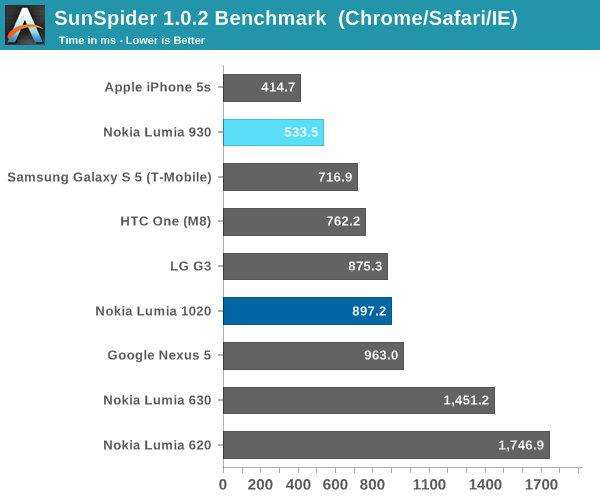
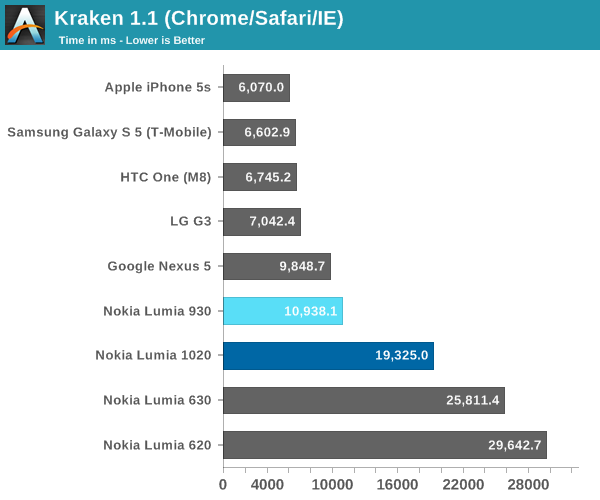
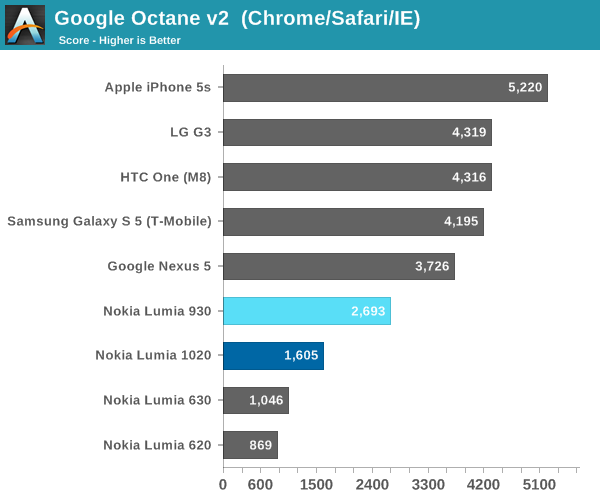
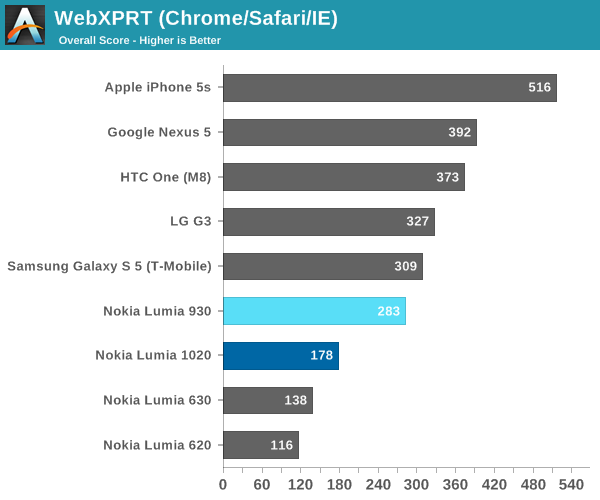
Sunspider has the Lumia 930 besting all but the iPhone 5s. Historically Internet Explorer has always done well at Sunspider though, and version 11 continues that trend. Unfortunately this benchmark has been optimized for by all companies. Moving up to more complex Javascript, we can see the difference with IE 11 compared to other browsers. The 930 falls behind the Google Nexus 5 which shares the same SoC, and it is well behind the Snapdragon 801 equipped phones. However the 930 scores almost half of the 1020 which is a great generational leap. A similar situation occurs on Google Octane, with the 930 behind the Nexus 5, but well ahead of last year’s Lumia devices. WebXPRT scores show the same trend. The Snapdragon 800 transforms Windows Phone into a contender. Javascript performance of IE 11 still is not as good as Chrome or Safari, but it is at least getting close with the latest version of the browser.
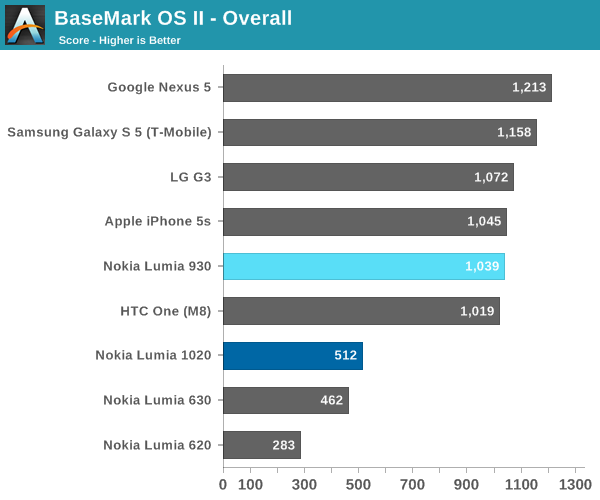
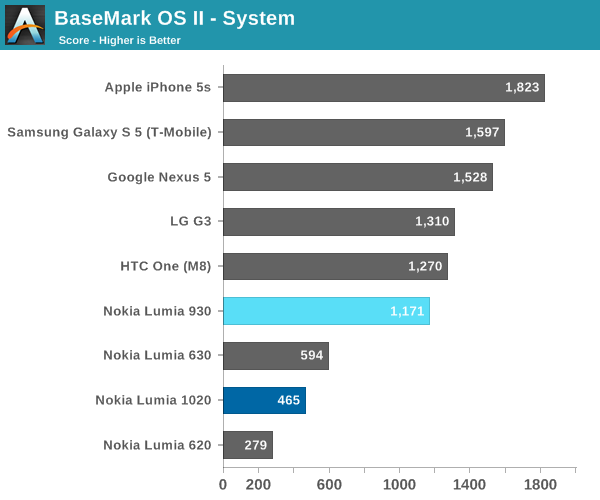
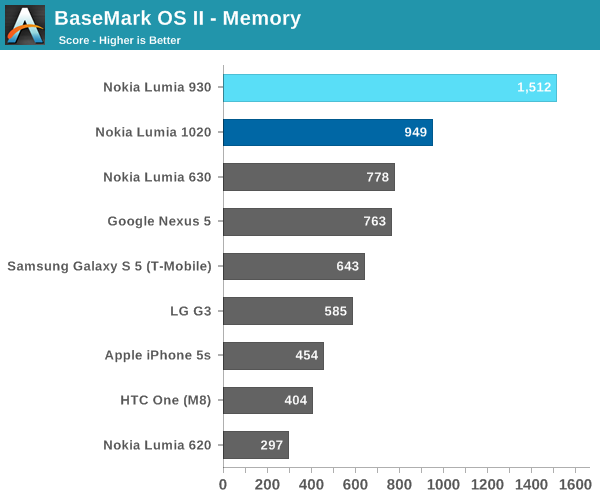
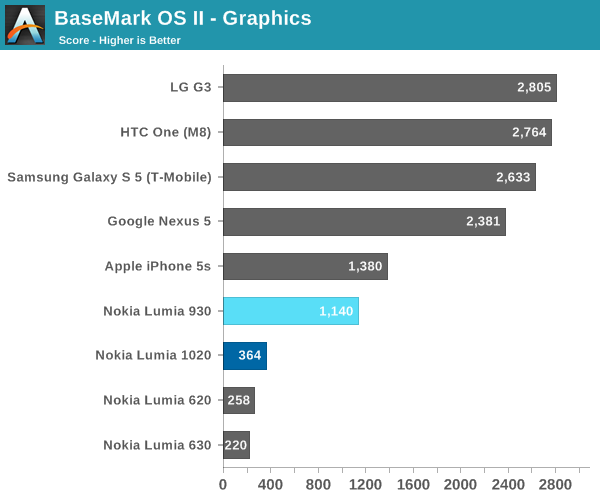
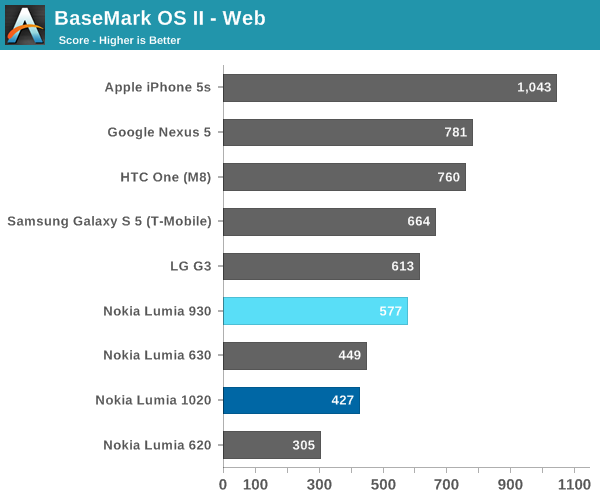
BaseMark runs as a native application, and therefore is not handicapped by the Javascript engine of the browser. Here the 930 performs well, with a score right around the same score as the iPhone 5s. Performance compared to the dual-core Krait 200 of the Lumia 1020 is once again pretty much doubled. Looking at the rest of the BaseMark scores, it becomes very clear how much of an improvement the 930 is over previous Windows Phones with MSM8960.
Graphics Performance
For GPU comparisons, we would normally turn to RightWare’s Basemark X 1.1, however a bug in the current version prevents it from running on the Lumia 1520 and Lumia 930. I have contacted them, and they have promised to look into it. If a patch is released, I will re-run the tests and update Bench. We do have access to GFXBench though, so let us see how the 930 performs.


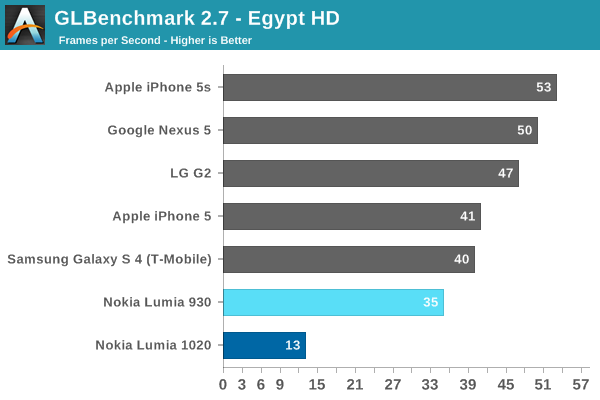
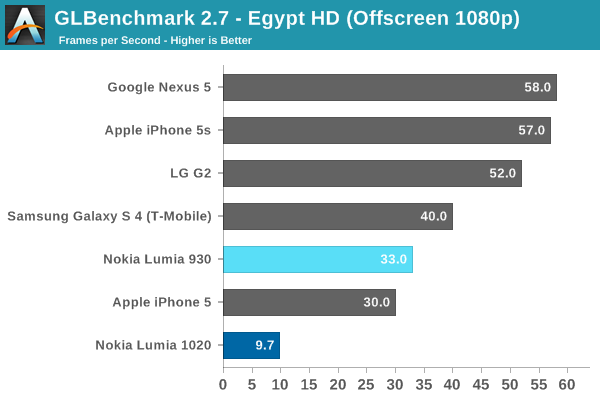
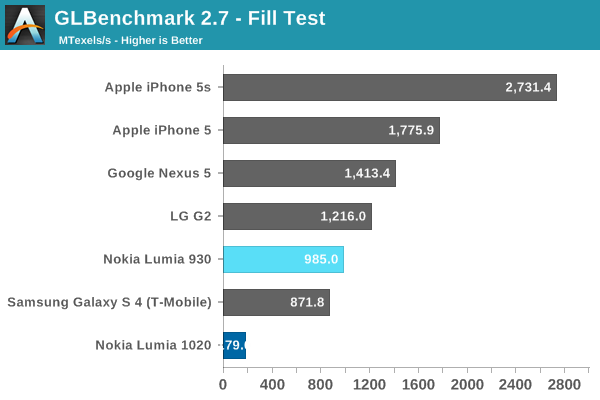
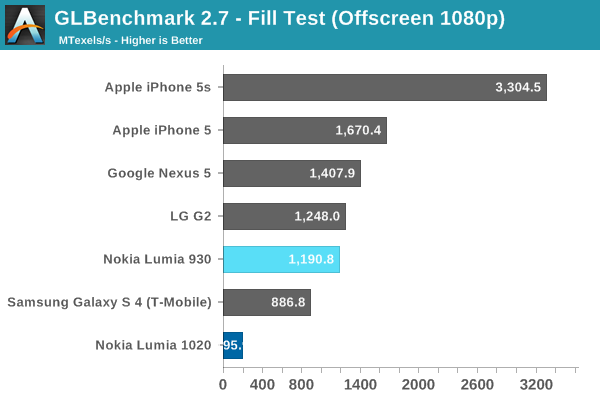


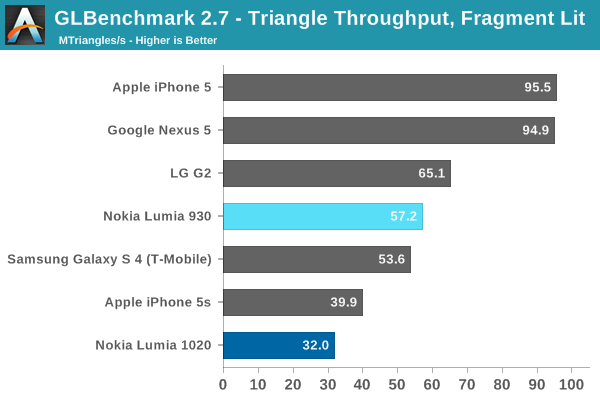
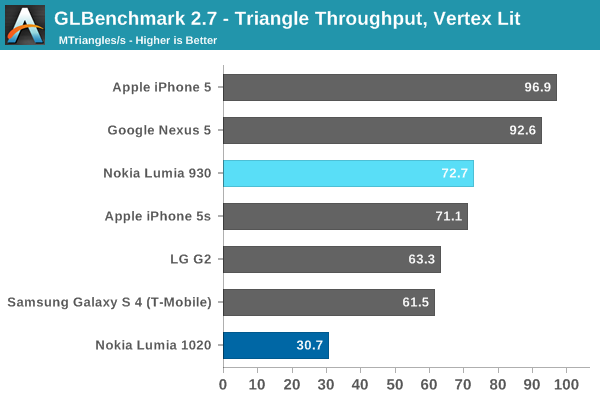

Version 2.7 of the benchmark is the current one for Windows Phone, with 3.0 listed as coming soon, however we can still get a glimpse at the huge performance leap from the last generation. While still not as quick through the benchmarks as Android and iOS, it is at least in the same room as them now.
Storage
Windows Phone does not support our storage benchmarking apps, and current ones in the store are either wildly inaccurate, or just provide abstract results. For this reason, we are going to create our own, but it is not ready yet. NAND performance was not tested on this device.
Performance Summary
One thing that Anand has harped on with regards to Windows Phone is that it is often on a much older SoC than competitive Android phones. This delta in performance is difficult to turn a blind eye to, even for supporters of the platform. With the 930 and Icon counterpart, Nokia has launched a phone which was on the most current SoC at the time of launch in February, which is a big step forward for Windows Phone performance. With the recent release of the HTC One (M8) for Windows, the platform now has the same SoC as most other flagship Android devices. That is a much bigger deal than many realize. The performance of Windows Phone has always been good on low end hardware, at least as far as the actual OS and animations, but in-app performance could suffer. The Lumia 930 is a breath of fresh air to Windows Phone and this one change alone is quite startling when compared to older devices.










115 Comments
View All Comments
pjcamp - Tuesday, September 9, 2014 - link
Not a dev. THE dev. Marcus Duarte himself claimed that users find two storage locations confusing.How we've muddled along with multiple storage locations on laptops all these years must confuse HIM to no end.
Besides this is Linux. It is possible to make a single file system spanning multiple devices. There's no reason Android couldn't clear up the "confusion" that way.
tuxRoller - Tuesday, September 9, 2014 - link
This ^I guess they've never heard of lvm/MD/btrfs.
Alexvrb - Tuesday, September 9, 2014 - link
That's not limited to Linux. I mean heck there's multiple approaches, some are completely software agnostic.Anyway, MS tried something like that with Windows Phone 7. It creates another problem when the user wants to REMOVE the memory card any time they want (users are stupid, this was a common complaint with WP7 I kid you not, result was WP8 separating the two again). WP 8.1 has a better middle-ground solution. Keep the spaces seperate but make better (and easier) use of the memory card.
BMNify - Monday, September 8, 2014 - link
Then get Lumia 1520 or 1320 or 630 or soon to be released Lumia 830 and 730, loads of options for MicroSD fanatics.jimbo2779 - Monday, September 8, 2014 - link
The issue is that this is meant to be the flagship phone at a reasonable size, the 1520 and 1320 are too big for the majority of users, the 830 is running a far inferior SoC, less RAM, poorer quality screen and camera, everything lower is in the same boat as the 830 or even worse so really the lack of SD card support here is it's main disappointment.I was looking forward to this phone so much only to find out it had no SD card support, any user of a Lumia (or other WP phone) with SD card support knows that it is so easy to use and allows for much more space than is available in a phone.
Would you rather have a phone with 32Gb or 96Gb? I know which I would prefer and I definitely would have bought a 930 outright to replace my 925 as this is an upgrade in every way but for some unknown reason they decided to make it the only phone in this years line-up without SD card support meaning it is a no go for me.
Reflex - Monday, September 8, 2014 - link
The question is what feature would you drop in order to gain that MicroSD slot? Because the 930/Icon is packed very tightly, it has everything that is in the 1520, yet in a full inch smaller package. Furthermore, it is barely larger overall than most 4.5" phones, so they really packed it tight.I am not willing to go with a larger phone. The features they did include are all very useful to me, I'd be pissed to lose, say, Qi charging, for a SD slot. I get that you want it all, but there are tradeoffs. Either you get the 930 with SD but without something else that takes up space, or you get it without SD support, or you get a larger phone that has all of it included (1520). The reason the 1520 exists is because there are some who are not willing to compromise. Quite frankly the 1520 is the phone you should be looking at, it was made with you in mind.
Also, the 520 has a SD slot not because its a high end feature but because it permits them to sell a phone with very little integrated storage, putting that part of the cost in the hands of the buyer.
Samus - Monday, September 8, 2014 - link
Most SD cards are slow, the controllers are slow, both add complexity and space to the PCB, most people rarely, if ever, use them, and most importantly, they drain the battery.If I were designing a small phone, I wouldn't put in external storage, either. Phablets and Tablets, sure...but with everything (especially WP8) becoming cloud-centric now, I don't see the need for physical media in a phone.
ummduh - Monday, September 8, 2014 - link
The cloud this, the cloud that, cloud, cloud, cloud cloud cloud.Do none of you people ever go outside the city you live in? End up in the mountains? The woods? A back country road that just happens to not have a signal?
I spend sometimes weeks on job sites out in the middle of nowhere with no signal. No wifi, either, since, ya know, it's a job site.
The cloud is 100% useless in those situations. Yea it's a neat toy, and can be handy when you never ever lose service. And you're willing to pay more and more for less and less data service.
Otherwise, you need storage on the device. 16GB, 32GB doesn't cut it. An endless supply is 64-128GB mSD cards, however, does. After apps are installed, I can only put a couple GB of music on my phone before it's filled. And then I get nagged to death by low storage warnings.
The cloud can go screw itself.
Reflex - Monday, September 8, 2014 - link
And in your situation that makes sense. However that is an edge case and the market really isn't, nor should it be, tailored to edge cases. Also, as someone who has compared coverage between carriers, I strongly suggest Verizon which tends to work just about everywhere, even in the backwoods, at least in the northern half of the country.ummduh - Monday, September 8, 2014 - link
So, I should pay extra amounts of money, every month, to stream the same data over and over to my phone, instead of carrying said data on my phone to begin with, and not keep incurring ever increasingly exorbitant monthly fees? What sense does that make?Pay to have the amount of data I'd need monthly (10GBish), over, and over, and over, and over.. etc. Or, $25 mSD?
It's not market tailoring, it's data fees extortion.